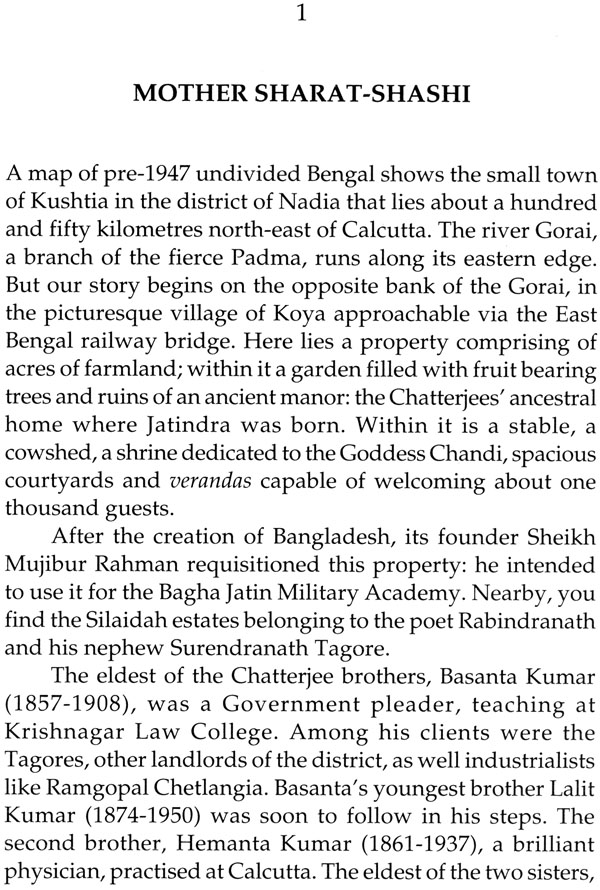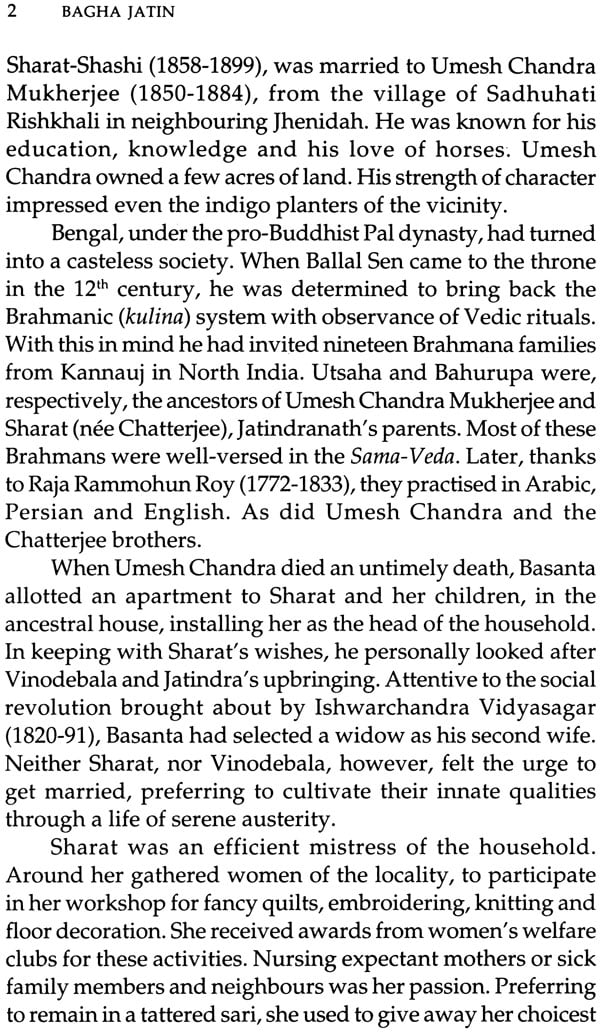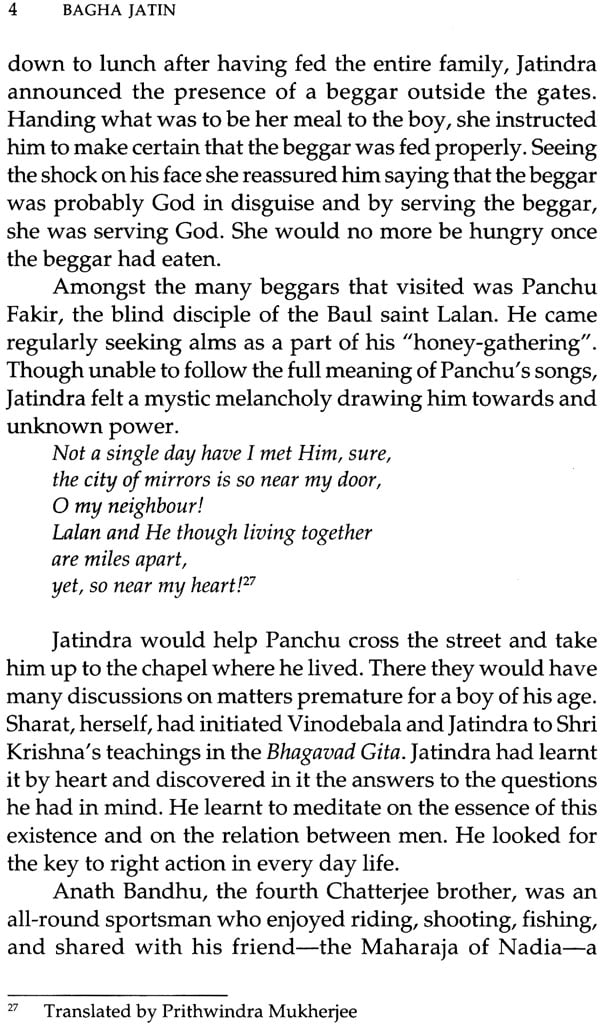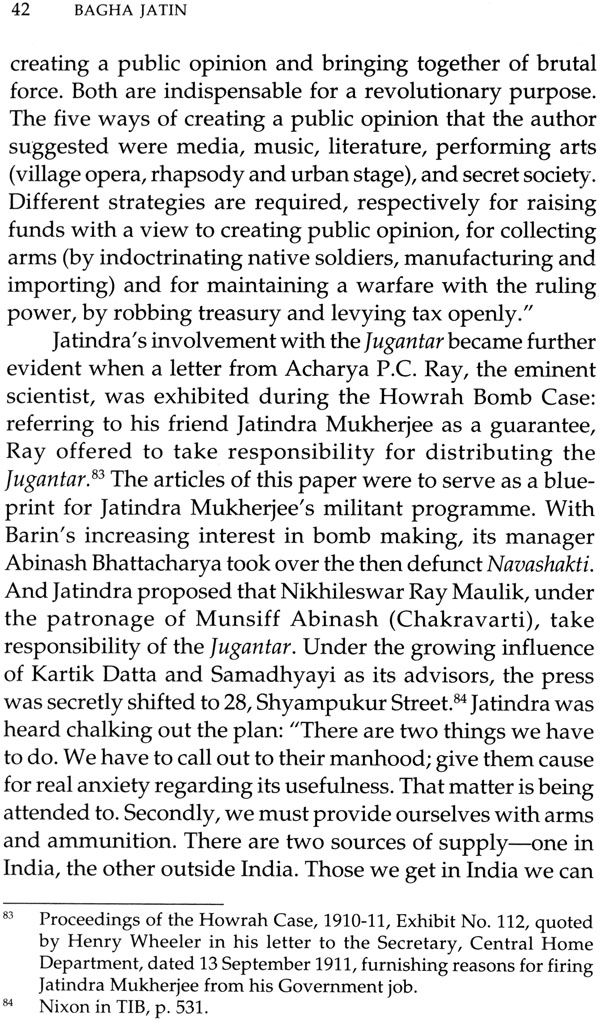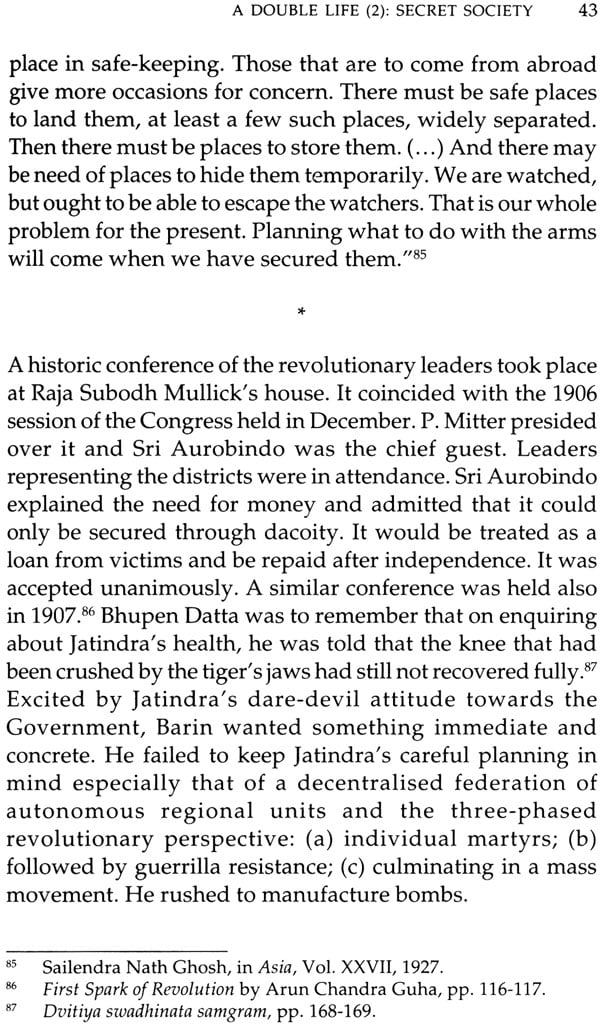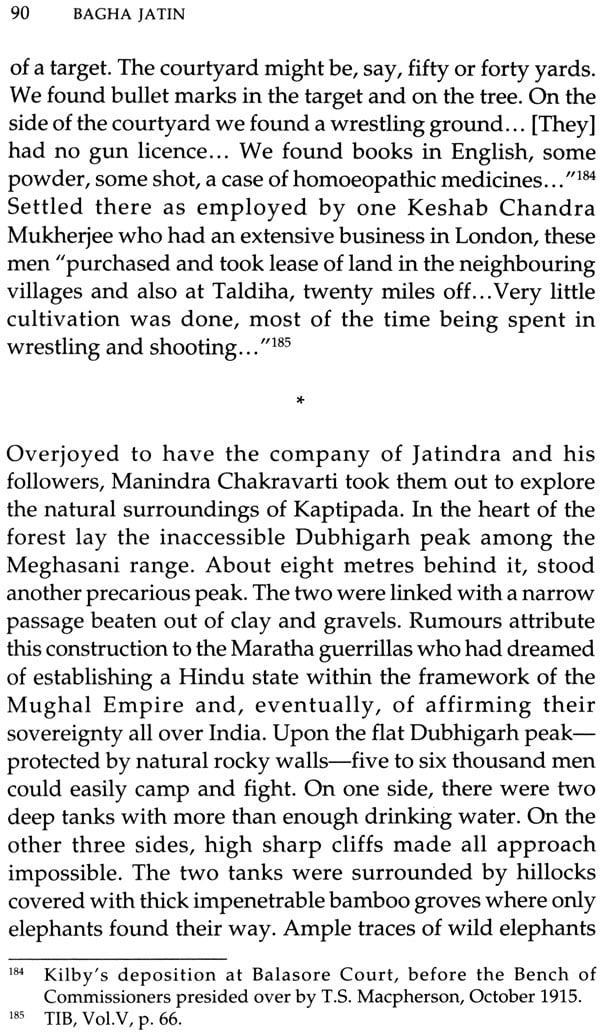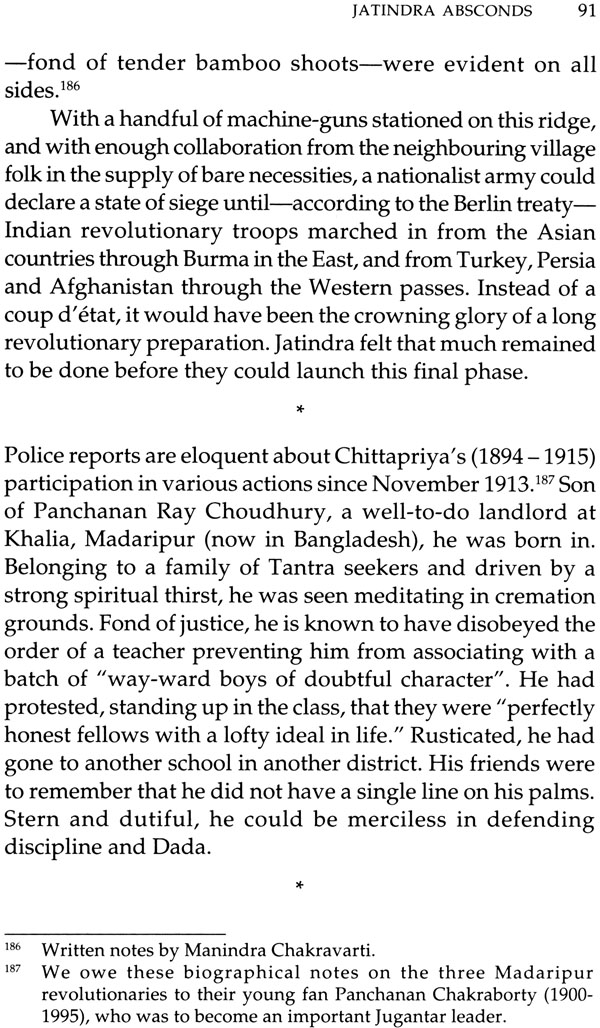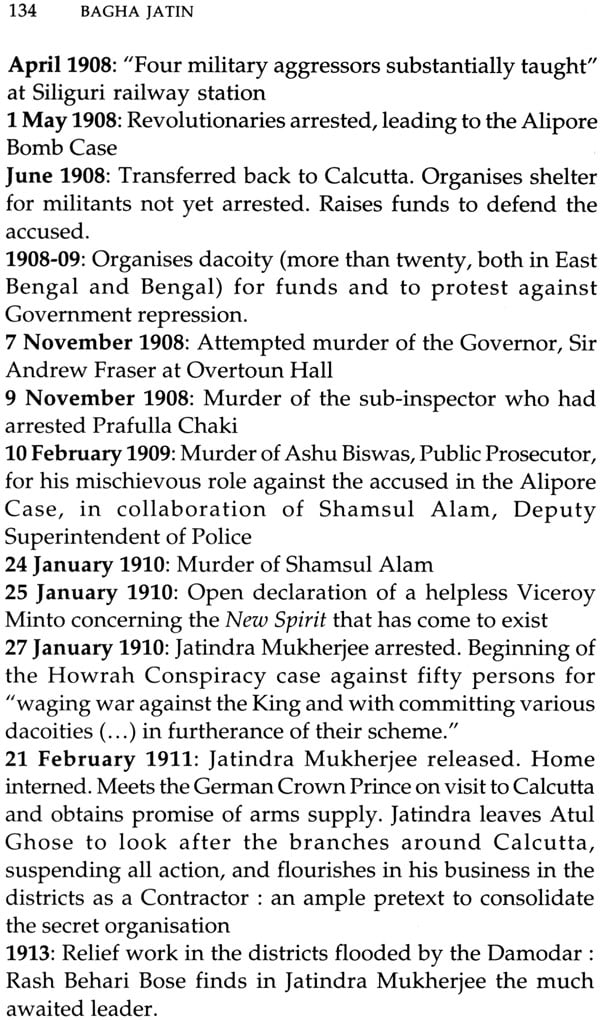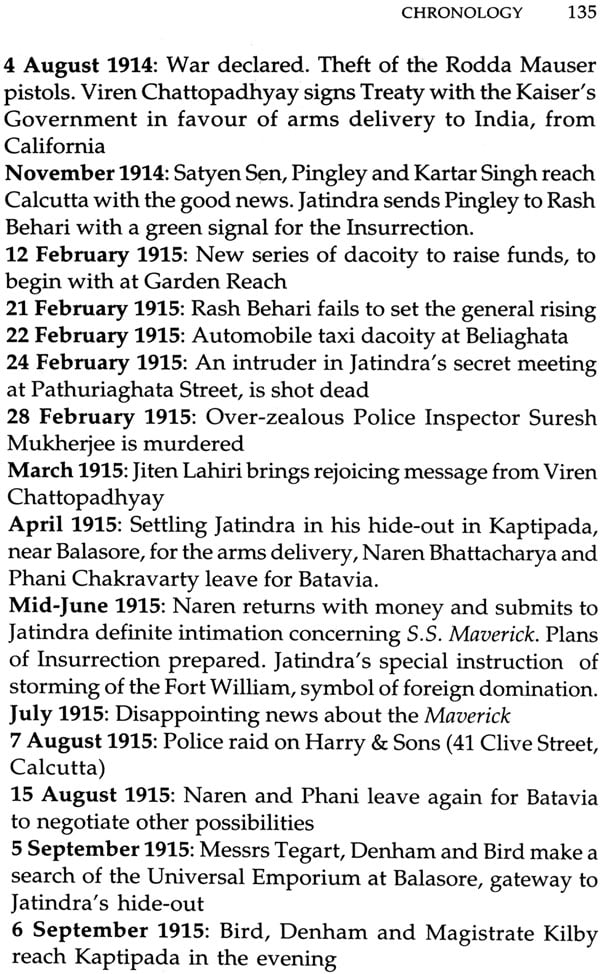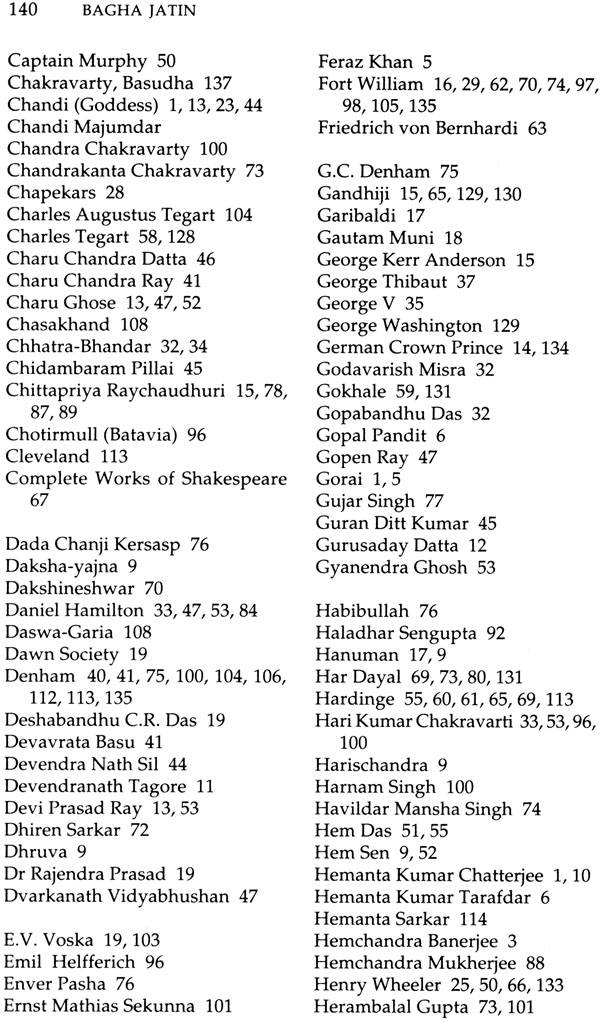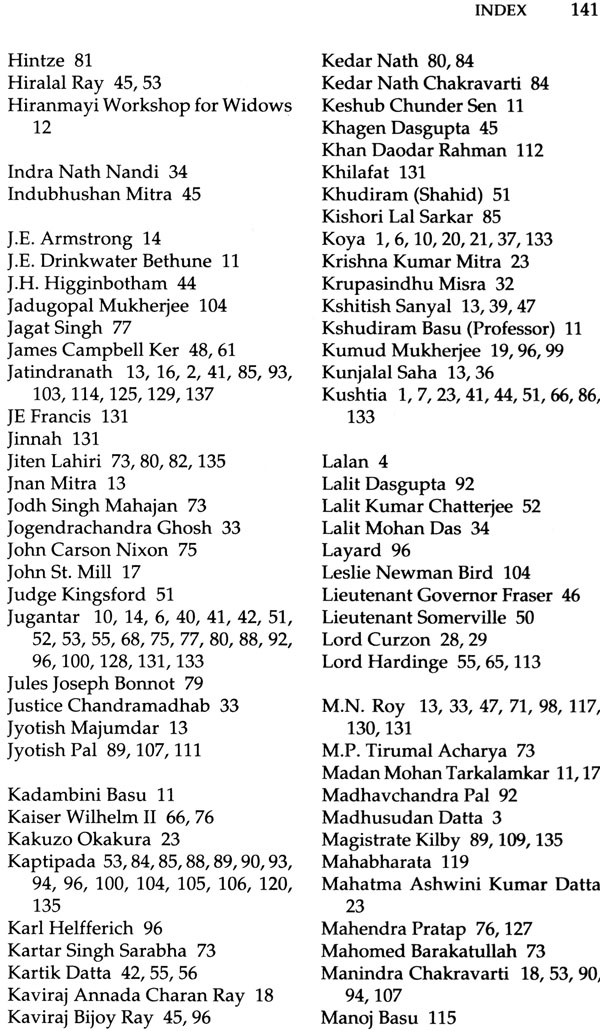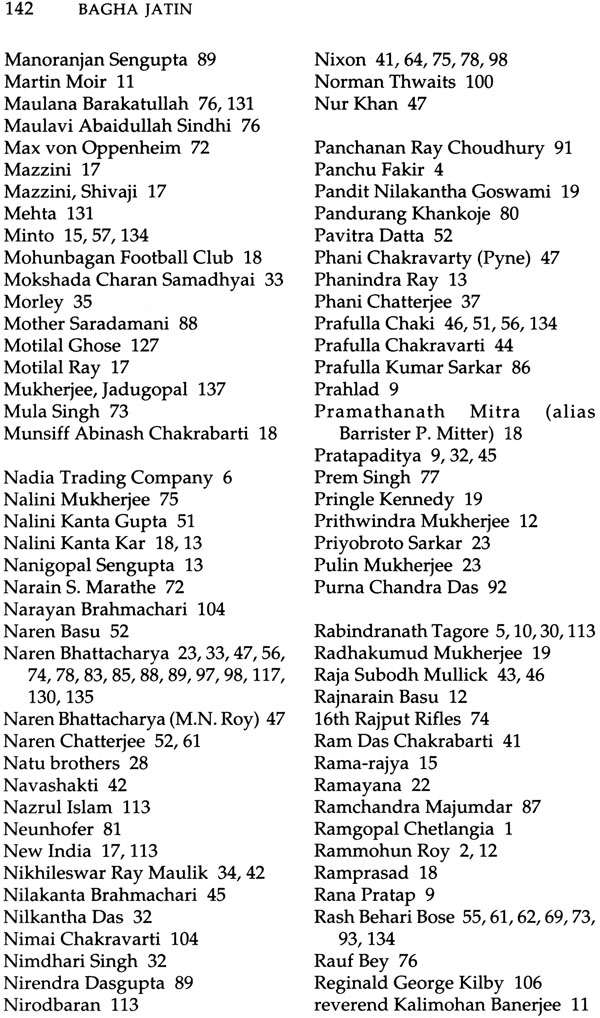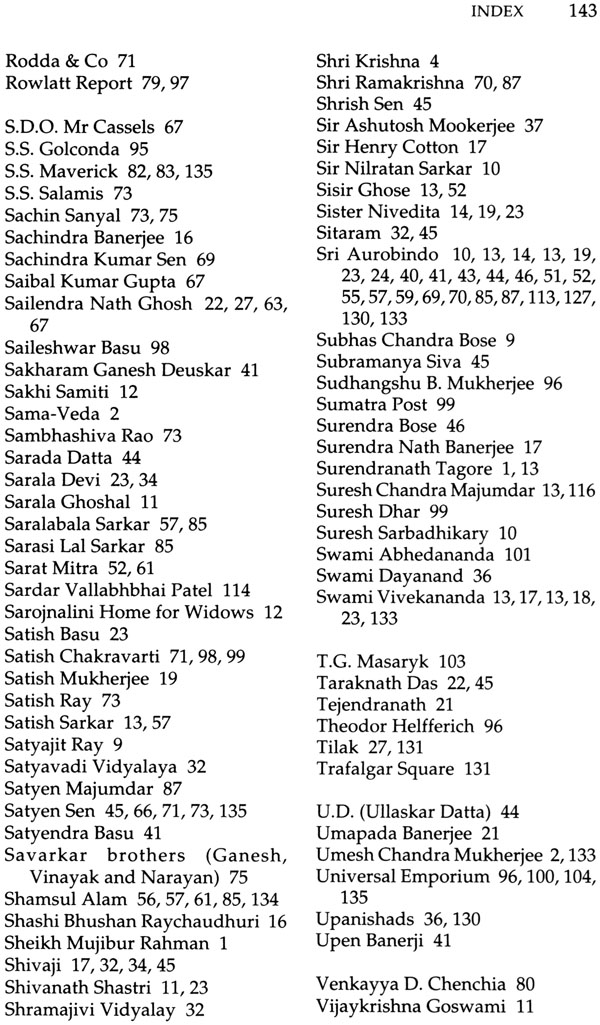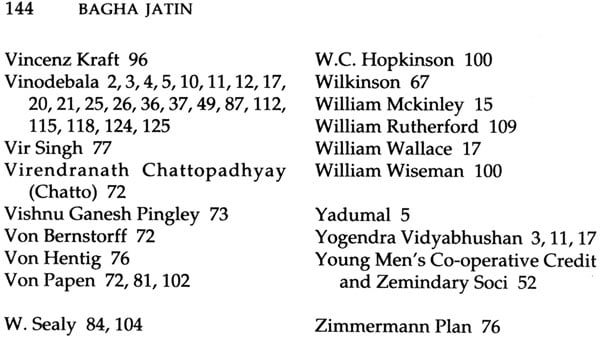
Bagha Jatin (Life And Times of Jatindranath Mukherjee)
Book Specification
| Item Code: | NAE016 |
| Author: | Prithwindra Mukerjee |
| Publisher: | National Book Trust, India |
| Language: | English |
| Edition: | 2010 |
| ISBN: | 9788123769714 |
| Pages: | 156 |
| Cover: | Paperback |
| Other Details | 8.5 inch x 5.5 inch |
| Weight | 220 gm |
Book Description
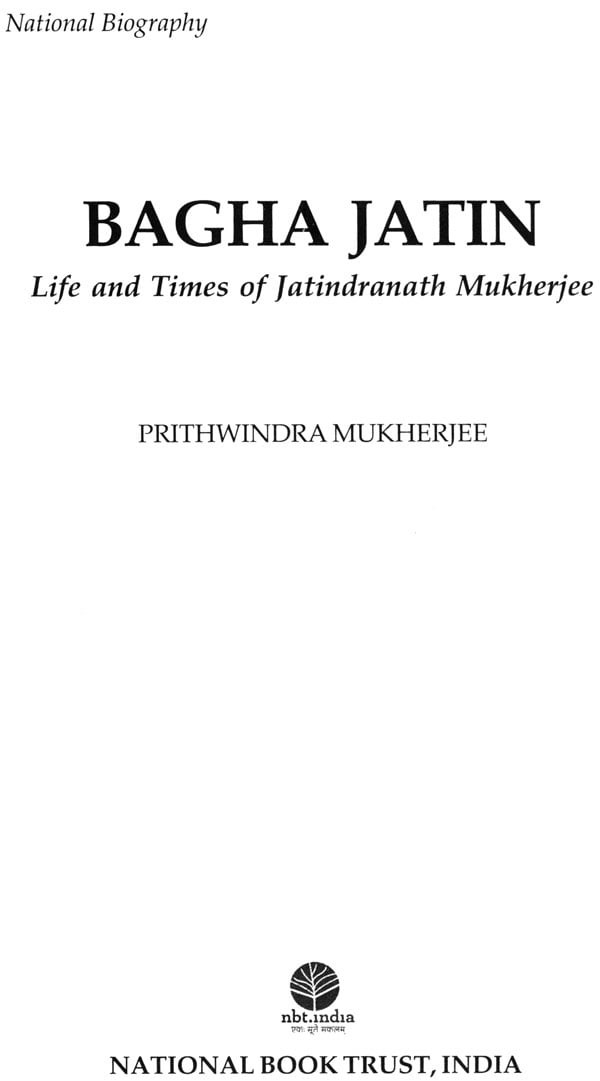
Inventor and architect of the Jugantar movement, Jatindranath Mukherjee (1879-1915) was popular as Bagha Jatin. Behind the minimalist image of a champion of physical strength, he was esteemed by those who knew Mm for his thirst for justice, his vision of an India politically free, socially modem and spiritually progressive. Believing in the enemy’s enemy as a practical philosophy, he negotiated with the German Crown Prince the delivery of arms for an insurrection; the Berlin Committee signed a treaty with the Kaiser’s ministers in favour of creating a socialist government in India. Preceding Gandhiji, Jatindranath prepared the field for a mass movement supplying arms both moral and military to an unarmed people half asleep under chronic bondage.
Paris-based since 1966, a retired scholar, Prithwindra Mukherjee (b. 20 October 1936) was initially known as a poet, a versatile exponent of Sri Aurobindo’s teachings, Bengali, French and English literature, comparative and creative musicology (Hindustani, Karnatic, Western classical and modern). As Jatindranath’s grandson, since his childhood, he had seen severe-looking adults shedding tears while talking of their hero. He started enquiring verbally beginning with Vmodebala Devi, Jatindra’s alter ego—and by correspondence with those who knew him, about the sort of man Jatindranath was. Fifty years of research in archives Indian, European and American (with a Fulbright scholarship) led him to discover that Jatindranath embodied the yearning of a people, an epoch, a movement. Prithwindra is author of more than fifty books and a good number of papers and articles.
In the midst of the chaos created by Subhas Chandra Bose’s resignation from the Presidentship of the National Congress, in 1939 Rabindranath Tagore, in a tribute to Bose, reminded that having contemplated the face of Bengal’s will power against the Partition of Bengal, he had seen how this will power had been able to resist the attempt to cut Bengal’s body asunder. He could not forget that the Bengalis had known how to unite against a power considerably dreadful, instead of having recourse to sophisticated debates on their limited capacity. They had just simply willed. Then, referring directly to Jatindra Mukherjee’s contribution, Tagore wrote:
In the subsequent generation, I could admire the firewombed will in the mind of young Bengalis. They were born with the light to kindle lamps all over the country, but inadvertently they set fire everywhere that even devoured them, turning the path into a blind alley. In the failure welling from this error, however, the magnanimity of the heroic hearts that shone forth, I have never seen anything like it elsewhere in India. Sacrifice upon sacrifice on their part, suffering upon suffering, this frenzy to immolate one’s life turned into ashes very soon, but they have, all the same, courageously expressed the indomitable will force of Bengal. Whatever be the judicious blames that seek to blacken the soul-rending mistake of the impatient youth, as recorded in this chapter of history, is it really possible to tarnish their innate nuclear irradiation?
Whereas the Anushilan (centralised in Dhaka) was paid to shun Gandhiji’s non-cooperation movement as reactionary, thanks to Jatindra Mukhejee’s revolutionary vision, his followers belonging to the Jugantar found therein the perspective culminating in the accomplishment of their objective: the Mass movement. As the mouthpiece of the Jugantar—leaderless and disoriented since the death of Jatindra Mukherjee—Bhupendrakumar Datta, one of Jatindra’s closest followers had consulted Sri Aurobindo at Pondicherry, about their option in the light of Gandhiji’s promise in 1920. Not at all persuaded that India could attain Swaraj within a year, the Master recognised the force that the new leader represented and advised collaborating with him without, however, making a fetish of non-violence. Accordingly, in 1923, when the Jugantar decided to act of its own, on 9 September it celebrated from Calcutta to Lahore the 8th anniversary of the Battle at Balasore, by issuing articles and books on Bagha Jatin. Young Bhagat Singh participated in it. The Government noted with interest this first disobedience to Gandhiji’s policy.
Thus they proved that the path did not become a blind alley, nor did the frenzy to immolate one’s life turn into ashes: the Phoenix of the time spirit soared high. Therefore, rectifying his statement, Tagore singled out Subhas Chandra as the Deshanayaka —Leader of the People—and invited him to accept the role of Jatindra Mukherjee’s successor:
Witness that we have been of the multiple weakness of our motherland, wherever we have discovered, all the same, proof of her strength, all our hope—hidden, underground—eagerly looks for the future. You will have, henceforth, the responsibility of making this expectation vigorous and pregnant; your duty will be to usher on the activist path the finest elements of the Bengali nature, all its faculties: its witty spirit, its imaginativeness, its clear sight to discern the new, its skill in creating forms, its spontaneous receptivity to the gifts of unknown cultures. Scrubbing all that is obsolete and worn out in this country, ridding its new energy of sheaths of inertia, come to assume the authority to help them blossom in a new springtide.
Since 1923, especially after 1947, numerous biographies-penned by more or less competent authors including the present writer—have appeared, trying to define who Jatindra Mukheijee or Bagha Jatin was. A host of memoirs and reminiscences by contemporary freedom fighters have added undertones and overtones to the rhapsody Here for the first time, in a nutshell, I present the true story of Bagha Jatin with reference to the vast revolution he had conceived and had set to realise with the dream of a glorious India. Bagha Jatin chose to suffer and taught his followers to do so in the name of a future India where citizens would be happy and prosperous in the midst of other free nations. Having largely drawn from some of my past publications in Bengali, English and French, and inspired by a relentless research since 1955, I take this opportunity to thank the publishers. Corresponding with and interviewing people who knew him, consulting various Indian, European and-thanks to a Fulbright scholarship—American archives, I discovered beyond the personality of Bagha Jatin the very symbol of an epoch, a movement, a spiritual urge. The eminent French historian Raymond Aron believed Bagha Jatin to embody the thinker in action who furnishes the ‘missing link’ in modern history.
My brother Togo Mukherjee and Dr Amitabha Chakrabarti have gone through the manuscript in earnest, and have detected ‘misprints and puzzling words’. Nevertheless, there maybe some variants of proper names. I thank Ishani (Catherine) for her constant encouragement and support. Since the late 60s, Martin Moir, Deputy Director of the British Library’s Oriental and India Office Collections helped me considerably in my research at archives. He too has gone through the manuscript and comments thus:
Bagha Jatin himself was at pains to issue strict orders to avoid killing innocent citizens, even though in practice it was not always possible to do this. So whereas contemporary British rulers saw a terrorist in Bagha Jatin, his many Indian sympathisers hailed him as a heroic freedom.... This new study seeks to reinstate Bagha Jatin as the great might-have-been creator of modern India, vividly evoking his...charismatic personality as well as the political background of early 20th century Bengal, with its growing currents of nationalist fervour drawing upon more traditional forms of cultural and religious expression.. .the narrative presents a series of detailed vignettes of Bagha Jatin’s life, culminating in his shooting and death in 1915.
I thank them all for their friendly gesture. 1 also take this opportunity to thank Smt. Nuzhat Hassan, Director of the prestigious NBT, and the kind editorial attention of Smt, Neera Jam. Furthermore, I thank Dhir Sarangi, Subroto Chattopadhyay and Varun Narain for their active presence in Delhi.
An inflammable inspiration accompanies the name Bagha Jatin, which means ‘Jatin, Valorous like a Tiger’. Though few people exactly know about the life and times of Jatin (Jatindranath Mukherjee), nobody is indifferent to a magnetic thrill kindled by his legendary nickname. On unanimous evidence, Jatindra was unique. “All dadas practised magnetism; only Jatin Mukherjee possessed it,” remembered MN. Roy. A philosopher who, in the forefront of revolutionary activities, lived up to his own teachings. At the root of his fight to decolonise India, there was no hatred for foreigners. The English he practised was chaste; he even caricatured the corrupt Anglo-Indian by-product. He had come close to several English personalities. Sri Autobindo, too, brought up in England, revealed to him the finest essence of English upbringing. Through them, Tatindra had an objective appraisal of the English character which, unhappily, was distinct from that of the average fficers who governed India and were, usually, far from railanthropy; mere chhoto ingre] (Petty Englishmen).
As a college student, drawn by a monastic life, Jatindra had met Swami Vivekananda, who persuaded him that even honest family man could lead a saintly life. Soon, Jatindra realised within himself the sprouting ideal of social and patriotic service that his mother had been sowing. Dedicated the cause of the miserable country folk, he joined the organised relief organised by Nivedita, the Swami’s Irish disciple. Vivekananda guided Jatindra gradually towards a political consideration for India in bondage and, initiating him to conquer libido, confided him the mission of forming young men “with iron muscles and nerves of steel”, for the political freedom of India: an indispensable step towards the spiritual progress of humanity. Nivedita admired Jatindra’s social and political leadership. In 1902 at Baroda, representing deceased Vivekananda’s wish before the emergent Extremist revolution as plaimed by Sri Aurobindo, she informed the latter that Bengal awaited him. By then, as a founder member of the Anushilan Samiti, Jatindra had been creating its branches all over. Anushilan had been Bankim Chandra’s vision of integral education. By dint of a stern attachment to discipline, Jatindra proved it to be humanly feasible.
On meeting Jatindra in 1903, Sri Aurobindo entrusted him with creating a secret society permitting the Jugantar perspective of swaraj (self-government). Sri Aurobindo was impressed by the “beauty and strength” of his right-hand man whose “very stature was like that of a warrior. A man who would belong to the front rank of humanity.” Convinced by the utility of the Extremist experience for India, Jatindra added to the scheme a few significant items such as indoctrination of the native soldiers, sending emissaries abroad for a proper military training and drawing international sympathy to help India wriggle out of slavery. Sensing the First World War to be imminent, Jatindra met personally the German Crown Prince on visit to Calcutta and obtained promise of arms for a general uprise.
Other than living up to his own teachings, Jatindra taught a generation of disarmed militants how to sacrifice everything for India. Before the nation was ready for a mass movement, he proposed two indispensable phases to awake it: (a) individual martyrdom; (b) guerrilla resistance. This very revolutionary perception helped his followers to collaborate with Gandhiji since 1920. Jatindra’s crowning success lay in executing his own principles in a creative fashion. An exceptional strategist, he improvised a trench fight before laying down in beauty his short life, for that nation in making. The highest tribute to India.
Owing to several obvious reasons, however, Jatindra has remained so little known. First of all, as creator of a secret society, he believed in mantra-gupti or absolute secrecy: ‘Jatindra lived like those giant whales in the unfathomable depths”. Secondly, our rulers of the epoch prevented the world from knowing the importance and the far-reaching impact of his well-calculated revolt against imperialism. We shall presently see, attested by official records, how consecutive viceroys (Minto and Hardinge) announced desperately their worry about the state of affairs under Jatindra’s leadership. Tegart of the police department admitted frankly that England would have been surely defeated in the First World War, had Jatindra’s scheme of an international revolutionary chain-work not been betrayed. Finally, people who knew Jatindra were convinced that he was ‘the personification of an entire epoch.’ Jatindra “was something more than an individual — nay, more than in important leader; he was the guiding spirit ... Jatin was looked upon by all revolutionary workers ... as the symbol f their hopes and aims.”
Beyond his physical beauty and fabulous strength, Tatindra lived in communion with what his associates called his soul-force. They knew that his immense capacity of concentration had for source an ethereal touch in his thought and action. Nothing appeared impossible in his presence: people experienced a joy and courage surcharging their body and mind.
I may venture to proclaim that he was the very personification of the Gita. Perhaps man can never attain integral perfection. But Jatindra Nath’ place is inevitably among those to have gone closest to perfection.... He belonged to an altogether different category of humanity, far above the reach of us, ordinary human creatures, far beyond us all. Always he seemed to come down to us, having lit the lamp of his soul in some untrodden height.
This inward plunge gave a rare dash to his projects. He was a great deal more than the ‘mastermind’ ... with a dower of humanity and innate generosity of soul which made him outstanding among the then national revolutionaries.”
Death, since his childhood, was an enigma for Jatindra. Before passing away in 1902, Swami Vivekananda had often reminded him how people in thousands died like insects; instead, they could die for a cause. At the age of five, Jatindra had lost his father. It was followed by the death of his little brother, and then his brother-in-law. In 1899, his mother died of contagion while nursing a cholera patient: this was a crowning lesson of self-sacrifice. Married in 1900, Jatindra lost his first child Atindra in 1905, during an epidemic of cholera. As a distressed pilgrim, at Haridwar, Jatindra recognised in Bholanand Gin the spiritual insight that could help him solve some riddles. Aware of his political commitment, the Guru promised him an inner support. Jatindra replied to his doubting associates about his need of a Guru, that—much like Hanuman—by taking the Guru’s name, he found his strength quadrupled. In one of his letters to his sister, he wrote: So often have you noted how ephemeral everything is, in this life. The person who has any chance of sacrificing this ephemeral life in this ephemeral world for the cause of Dharma is, indeed, ever so fortunate.
Jatindra loved contemplating the sky at night for hours. On one occasion, a young follower observed him meditating on the terrace of the Daulatpur College hostel: “That face, those eyes, that chest of Jatinda’s have some relation, some similarity with the sky. Rabindranath considered the sun to be his companion; that sky, too, seemed to be Jatinda’s companion.” Motilal Ray has recorded that—in 1913—at the dead of night, during the relief work of the Damodar flood, spell-bound, he was drawn by a poignant and mellifluous voice: far away in the camp, someone in utter devotion was singing a hymn to the Mother by Ramprasad. It was Jatindra.
On the eve of his absconding—six months before he fought and died, Jatindra met his Guru in Calcutta. While leaving the place after visiting Bholanand Gin, Jatindra told the associate present: .Gurudev has incited me to run forward in absolute liberty...” During the months in his hide-out in Orissa, a shadow of famine hovered over the countryside. Young Chittapriya caught the infection of cholera. In a half-conscious state he repeated to the comrades what Dada (Jatindra) had taught:
‘We are not to die of old age, disease and accident. We must die fighting, bleeding for the Mother.” A few months later, Chittapriya was to fight and die by Jatindra’s side.
Every afternoon, before sunset, Jatindra held there a class, reciting and explaining verses of the Gita. Reminiscent of those meetings, Nalinikanta Kar has written identifying the leader with Gotam Muni uttering mystic hymns. Respectful yet curious about Jatindra’s quest of an inner perfection, Manindra Chakravarti (who took care of his revolutionary guests) liked to watch him meditate in the Eorest, after the Gita sessions. At times he sat near Jatindrabn with a hope to receive some light from the pious man. One evening while Jatindra was still contemplating the setting sun, and Manh dra was about to leave, Jatindra exclaimed: Can you see Him? Look there, my Krishna smiling at us!
A Czech spy active in the USA discovered the Indo-German plans of arms delivery from California to India and sold the information to American and British authorities. Years of strenuous preparation through Asia, Europe and America fizzled out. Jatindra went through the press cutting announcing this calamity and declared with a hearty laughter that God has rectified their decision: “India has to rise with her own strength.” A Czech historian has admitted:
“Had E.V. Voska not intertered in this history, today nobody would have heard about Mahatma Gandhi and the Father of the Nation would have been Bagha Jatin.
When, in September 1915, l3eshabandhu CR, Das received news of Jatindra’s heroic self-giving, all in tears, he lamented: “We have misused the shalgram stone for grinding spices!” Like Das, many people observed the Hindu rituals prescribed to honour a deceased relative. This confirmed the hypothesis that—engaged in the freedom struggle—the role that Jatindra had assumed as an activist leader was undoubtedly a part of his innate spiritual seeking.
A quick and superficial reading through the main events in the life of Jatindranath Mukherjee (1879-1915)-also known as Bagha Jatin-might suggest that he was a fairly conventional early Indian freedom fighter, killed in 1915 after mounting several attacks on the Raj and its representatives, leaving his Jugantar followers weakened, and the eventual leadership of India Swaraj in the more versatile hands of Gandhi and Nehru etc. But in his careful retracing of his grandfather's career, Dr Prithwindra Mukherjee shows that Bagha [atin was a far more visionary, complex, open-minded and influential figure than the preceding sketch would indicate. Yes, Bagha [atin was ready on occasions to take up arms against the government, but he was also always careful to instruct his followers to try their best to avoid killing innocent bystanders (unlike some of today's political militants), also ready to try other forms of economic pressure such as boycotts, and prepared to sanction longish periods of truce as part of his broader strategic plans. But most interestingly, here and elsewhere, Mukherjee articulates the wider historical thesis that through his bold attacks on the Raj, his long-term freedom strategy, and eventual self- sacrifice, Bagha Jatin actually inspired many of his fellow countrymen to take up the cause of Indian independence, for almost the first time imbuing them with confidence in their eventual ability to dislodge British rule. In other words, the later mass movements led by Gandhi and others were able to capitalize on the earlier development in national consciousness partly brought about by Bagha Jatin himself and other seminal figures such as Sri Aurobindo (1872-1950).
So in developing and illustrating these themes, Mukherjee in fact seeks to confirm Bagha Jatin's status as one of the insufficiently acknowledged creators of modern India, vividly evoking his hero's charismatic personality, as well as the political and cultural background of early 20th century Bengal with its growing currents of nationalist fervour fired by the partition of the province. Using a wide range of source materials in different languages-published, unpublished, archival and oral-Mukherjee's narrative presents a series of closely observed vignettes of Bagha Jatin's life culminating in his shooting and death in 1915.
If Bagha Jatin had survived and succeeded in his ambitious plans for Indian independence, what sort of India would we have today? Wisely, Prithwindra Mukherjee refrains from pursuing this kind of speculation too far but his engaging biography certainly leaves such ideas lingering in the mind.
> >
| Preface | VII | |
| Introduction | XI | |
| 1 | Mother sharat shashi | 1 |
| 2 | Calcutta central college (1898) | 10 |
| 3 | A double life (1) HM's servent | 20 |
| 4 | A double life (2) Secret society | 39 |
| 5 | Howrah conspiracy case | 52 |
| 6 | Release a new perspective | 61 |
| 7 | Insurrection first steps | 68 |
| 8 | Jatindra absconds | 79 |
| 9 | Balasore Haldighat of modern India | 99 |
| 10 | The good man anecdotes | 110 |
| 11 | Letters by jatindra | 114 |
| 12 | Epilogue | 123 |
| Chronology | 129 | |
| Bibliography | 133 |
